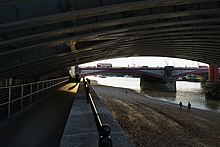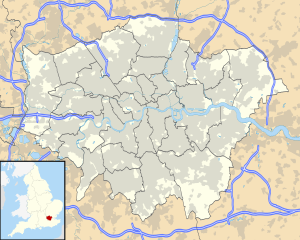Blackfriars Bridge
Coordinates: 51 ° 30 ′ 35 ″ N , 0 ° 6 ′ 16 ″ W.
| Blackfriars Bridge | ||
|---|---|---|
| Blackfriars Bridge, with St Paul's Cathedral in the background | ||
| use | Road bridge | |
| Convicted | Main road |
|
| Crossing of | Thames | |
| place | London | |
| construction | Arch bridge | |
| overall length | 281 m | |
| width | 32 m | |
| opening | 1st bridge - 1769 2nd bridge - November 6th, 1869 |
|
| location | ||
|
|
||
The Blackfriars Bridge is a road bridge over the River Thames in London . It connects the City of London on the north side with the district of Southwark in the London Borough of Southwark on the south side. It is located right next to Blackfriars train station and is named after a Dominican monastery (English black friars ) that once stood in the vicinity. It is owned by Bridge House Estates , a Corporation of London charity .
The 281 meter long and 32 meter wide bridge consists of five wrought iron arches and a cast iron balustrade in the Venetian style. Sculptures created by John Birnie Philip are reminiscent of the Dominicans who used to live here; on the west side these are birds and flowers, on the east side sea plants and water birds. The main road A201 leads over the bridge .
history


First bridge
After a competition, Robert Mylne was commissioned to build a new bridge in 1760. The 303 meter long and 13 meter wide bridge was opened in 1769. It consisted of nine semi-elliptical arches made of Portland limestone . Initially the bridge was called William Pitt Bridge (after the then Prime Minister William Pitt ), but was renamed Blackfriars Bridge as part of the opening . First of all, bridge tolls had to be paid. However, during the Gordon Riots of 1780, the toll stations were ambushed and looted, resulting in the lifting of the bridge toll in 1785.
The salt water entering with the flood and the water of the polluted River Fleet caused significant damage to the limestone arches over time. The bridge was finally torn down in 1860 and temporarily replaced with an auxiliary bridge at the same point.
Second bridge
The bridge that exists today was built under the direction of Joseph Cubitt, at the same time as the immediately adjacent Blackfriars Railway Bridge . The official opening took place on November 6, 1869 by Queen Victoria , for whom a memorial was erected on the bridge in 1897. Due to the steadily increasing traffic, the bridge had to be widened by eleven meters between 1907 and 1910.
On June 18, 1982, the famous Italian banker Roberto Calvi was found hanged under the bridge.
Web links
Individual evidence
- ^ Walter Thornbury: Farringdon Street, Holborn Viaduct and St. Andrew's church . In: Old and New London . tape 2 , 1878, p. 496-513 ( British History Online [accessed November 6, 2019]).
- ^ Meyer's Large Conversational Lexicon . 6th edition. Bibliographisches Institut, Leipzig / Vienna 1909 ( zeno.org [accessed on November 6, 2019] lexicon entry "London").
|
Upstream Garden Bridge (planned) Tunnel of the Waterloo & City Line |
River crossings of the Thames |
downstream Blackfriars Railway Bridge |


